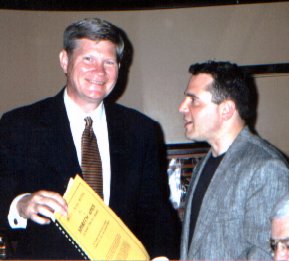

SPIRITSCAPES
(A South Dakota Cantata)
Audio Samples:"South Dakota" Sheet Music Download:PDF format of "South Dakota" in S.A.T.B. (unaccompanied) arrangement by the composer. Click Here.Instrumentation*:Piccolo, Flutes, Oboes, Bassoons, Bb Clarinets I, II, III, Bass Clarinet, Alto Sax I, II, Tenor Sax, Baritone Sax, Soprano Soloist, Baritone Soloist, Mixed Chorus [S.A.T.B.], Bb Cornets I,II,III, Bb Trumpets I,II, Horns in F I-IV, Tenor Trombone I, II, Bass Trombone, Euphonium, Tuba, Timpani, and Percussion I-III.; Chorus [S.A.T.B]; and Soprano and Baritone soloists.*an alternate version of movement V, "South Dakota" exists for chorus [S.A.T.B.] and piano.Duration: ca. 22 minutesPerformance history:Performed by the Sioux Falls Municipal Band and Master Singers at Falls Park, Sioux Falls on July 4, 2000. Encore performance was presented on July 7th, 2000 at the Washington Arts Pavillion.Availability: Score/parts available for rental from:Coho Music Publications518.438.4651Program notes
At its essence, Spiritscapes is a musical celebration of time and place. The notion of time came to me directly from the Continental Harmony commission. The commission, from the American Composers Forum and the National Endowment for the Arts, was established as a national commemoration of the new millennium. That my music addresses the concept of place is also a result of the Continental Harmony project. As part of this national endeavor, composers were selected to work in partnership with communities in each of the fifty states. I was fortunate to have been chosen to write a work for South Dakota. So, in consideration of the vast expanse of the millennium and the vast expanse of the majestic South Dakota landscape, I knew from the start that I needed to write a composition of significant breadth and proportion (the trick was, however, to compose a work that would represent a millennium without sounding like it lasts that long!).
Because I was asked to write my composition for chorus, concert band and two vocal soloists, I decided to construct the work using the general framework of a Baroque cantata. A cantata is a multi-sectional composition for singers and instrumentalists, often of a spiritual nature (Bach wrote hundreds of these). As in the Baroque model, sections within Spiritscapes alternate between arias (full-blown melodies for the soloists), recitatives (passages for the soloists which sound more declamatory in nature), and choruses. My composition is also reminiscent of the Baroque cantata in that it does contain a spiritual element. Indeed, it seemed to me inconceivable that a celebration of time and place could be anything but a celebration of the human spirit.
Within Spiritscapes, I devoted two movements to specifically reflecting the beauty and diversity of the South Dakota landscape (a landscape I came to understand well during my residency in South Dakota in the summer of 1999). In the second movement, "Maco Sica," I strive to paint a musical portrait of the Badlands. Here I use wide leaps and concise melodic fragments to represent the jagged peaks. Also, the melody often ascends, again reflecting the heaven-bound nature of the "Hills" in general. The third movement, "The Plains," stands in direct contrast to the second movement. This movement, for soprano soloist and chorus, uses a lilting 6/8 rhythm, a broader, more lyrical melody, and at times cascading melodic phrases to represent the tranquillity of the rolling plains.
While considerations of time and place certainly inspired the many broad, sweeping gestures found in Spiritscapes, I also intended for this work to reflect the human side as well. The lively, energetic overture was inspired by the dynamic community spirit I experienced while residing in Sioux Falls during my 1999 visit. The fourth and fifth movements, "Green and Gold" and "South Dakota," explore the relationship between South Dakotans and their land. Indeed, I was greatly inspired by the deep respect and affection South Dakotans have for their land--for its ability to sustain and nurture. So, to underscore this idea, I decided to insert the first two verses of Psalm 23 ("The Lord is my shepherd..") into the middle of the fourth movement. Indeed, I consider this section to be the climax of the entire work (one other important feature of this section is that in tribute to the rich heritage of the state, the psalm text is offered in Dakota translation).
One of the high points of writing Spiritscapes was the collaboration between myself and Sioux Falls poet Carla Fauske. I asked Ms. Fauske to write the texts for the last two movements, since these movements dealt most intimately with the relationship between South Dakotans and their state. Interestingly, Carla and I took turns taking the lead in the creative process. For "Green and Gold" I relied on her words to inspire my music, and for "South Dakota" my music became the basis for her words. As for the work's conclusion, my desire was to have music and lyrics that would truly embrace the South Dakota idea of community. For my part, I wrote a melody that I felt could be sung (or hummed or whistled) by everyone. In fact, at the end of my score, I direct the conductor to cue the audience--that is, to invite everyone to join. I can't express how delighted I was to have received Carla's words which complemented my melody so well and seemed to immediately reflect everything I was trying to say musically:
We welcome trav'lers home to South Dakota,
Where seasons change and neighbors lend a hand.
How blessed we are to live in South Dakota,
To know the grace and glory of this land.© Carla Fauske, 2000
Spiritscapes is music that commemorates a special time and a special place. It was written for South Dakota musicians and intended for a South Dakota audience. It is music that I hope will sung and played and enjoyed for many years to come. As for me, Spiritscapes will reside within me to become absorbed into my overall creative style. Spiritscapes, the land and people it represents, will always be a part of me.